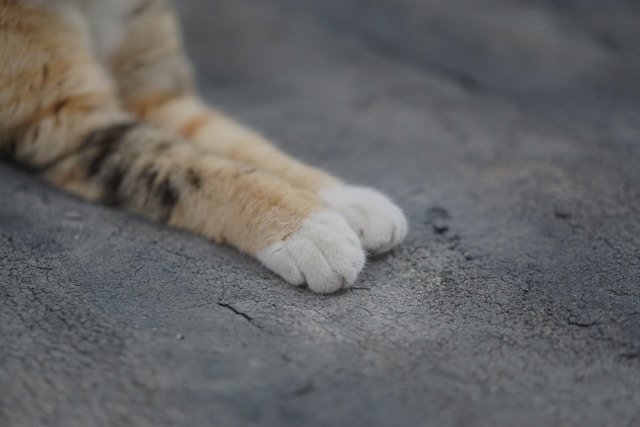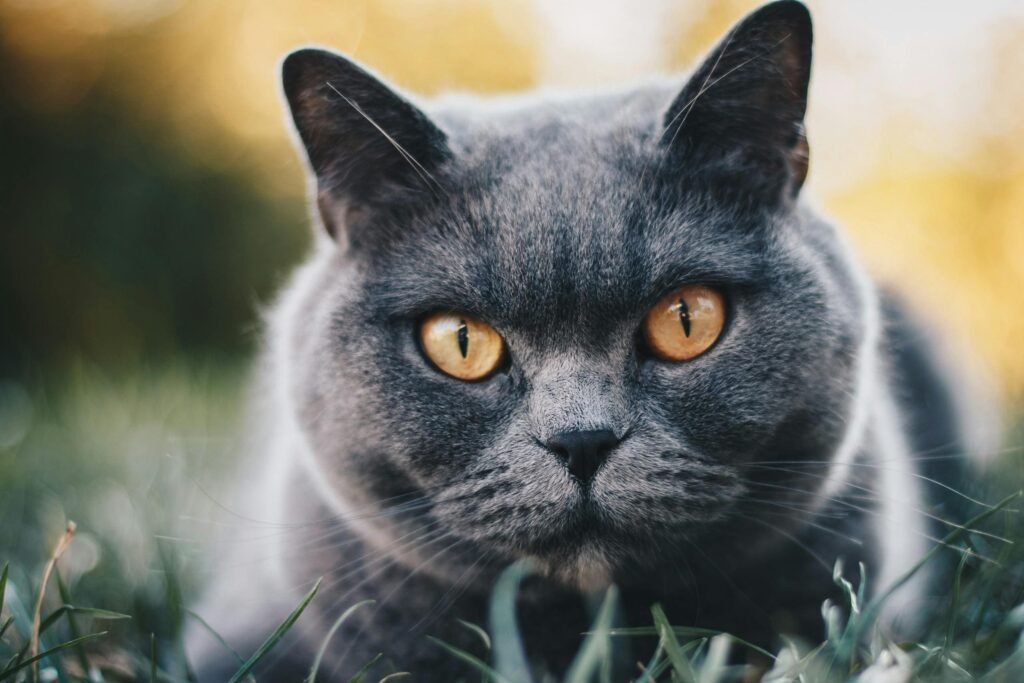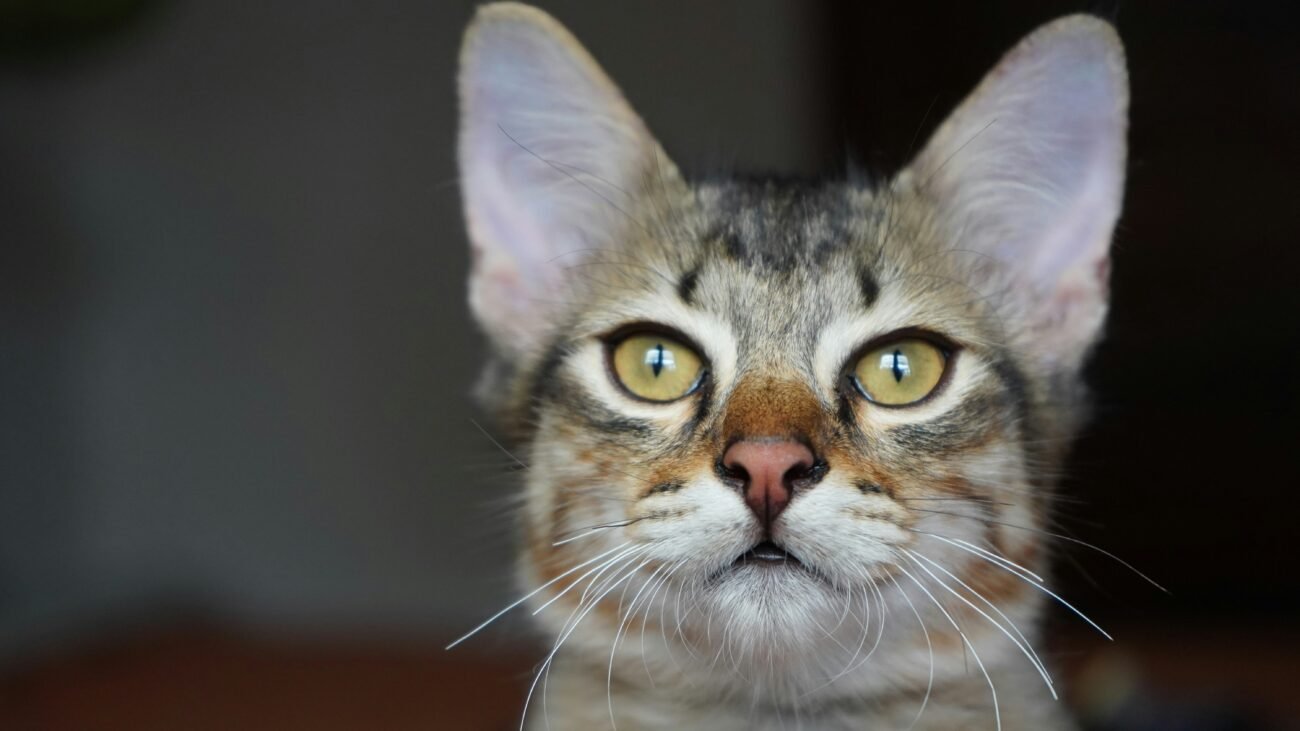Cats experience the world through incredibly sharp senses that work together in perfect harmony. Their whiskers act like antennas, detecting air movements and objects nearby, while their ears rotate like satellite dishes to catch even the faintest sounds.
Every sense — smell, sight, touch, taste, and hearing — supports the others, helping cats leap, climb, and balance with precision. This coordination allows them to perform amazing skills that often seem almost magical to us.
Understanding how your cat’s senses function gives a glimpse into their fascinating world — one filled with vivid focus, fine-tuned instincts, and a unique way of perceiving life around them.
Sight – How Cats See the World
Cats have extraordinary night vision, thanks to a reflective layer behind the retina called the tapetum lucidum, which lets them see in just one-sixth of the light humans need. Their retina is packed with rods for detecting motion in dim light, though their visual acuity (around 20/100–20/200) makes them slightly nearsighted. The slit-like pupils expand at dusk and dawn, adjusting quickly to light changes — an advantage during hunting.
Unlike humans, cats are dichromats; they see mainly blue and yellow but struggle with red and green hues. Their wide 200° field of view and strong binocular vision give them excellent depth perception, perfect for spotting prey through tall grass. A subtle visual streak across the retina sharpens their focus on moving objects, while the nictitating membrane (third eyelid) keeps their eyes protected and moist — a clever design for a natural-born predator.
Hearing – The Cat’s Exceptional Auditory Abilities
Cats are built with one of the most refined hearing systems in the animal world — a true marvel of feline engineering. Their cone-shaped ears act like mini satellite dishes, rotating up to 180° to capture even the faintest rustle in the leaves. While humans can detect sounds up to about 20,000 Hz, cats can hear nearly three times higher frequencies, allowing them to pick up the ultrasonic squeaks of rodents — a skill that perfectly matches their predatory nature. Even a kitten learns early to perk up its ears and investigate new sounds, a behavior deeply wired into feline instinct.
A cat’s ear isn’t just for hearing; it’s also a vital communication tool. From a calm purr to a startled hiss, each sound carries meaning. Cats rely on their ears to amplify and detect noises, not only for hunting but also to read social cues from their environment — a subtle flick or twitch can indicate curiosity, alertness, or even affection.
Interestingly, some people believe that white cats with blue eyes are always deaf, but science says otherwise. While it’s true that certain genetic traits make some of these cats more prone to hearing loss, it’s not universal. Many white cats hear perfectly well — a reminder that anecdotal accounts often blur the line between myth and biology.
Anatomically, a cat’s ear has three parts — the outer ear that funnels sound, the middle ear that amplifies it, and the inner ear that pinpoints where the noise is coming from. This intricate structure helps them detect prey or avoid danger with pinpoint accuracy. In short, a cat’s auditory system is a fine-tuned detection mechanism, evolved over thousands of years to make them expert listeners in a noisy world.
Smell – The Power Behind a Cat’s Nose

Anatomy & function
Cats have an enormous olfactory apparatus: estimates show 45–200 million odor-sensitive cells in their noses and a large olfactory epithelium (≈20 cm²).
They also possess a vomeronasal (Jacobson’s) organ on the roof of the mouth. When a cat gapes (muzzle wrinkled, tongue out) it opens this passage to sample pheromones — the classic Flehmen response.
Together, olfactory receptor neurons (ORNs) and the Jacobson’s organ let cats detect chemical cues humans miss.
Scent communication & territory
Cats use scent for social signals and territory: cheek rubs, paw pads, flanks and tail glands all leave messages for other cats.
This is why cats rely on smell more than sight when identifying people, food, or a new sofa.
Veterinarians (e.g., Dr. Eric Broad, Dr. Pam Johnson Bennett) note that scent-marking is key to feline comfort and social bonding.
Distance detection
Studies and field estimates vary, but most agree cats smell far better than we do — figures range from ~9–16× to higher multiples depending on the metric.
That sensitivity helps them locate prey, detect estrus signals, and notice faint changes in the home environment.
Practically, a hidden food stash or unfamiliar scent on a guest can be obvious to your cat long before you notice it.
Comparisons to humans (practical takeaways).
Compared with people, cats are built to parse chemical detail rather than color detail: scent is their primary information channel.
For owners: limit strong perfumes, scented litter changes, and sudden odor sources to reduce stress.
Quick tip: when introducing a new item, leave it in the cat’s space for a day so they can sniff and accept it calmly.
Taste – Understanding What Cats Prefer
Sweetness & Meat Preference:
Unlike humans, with about 9,000 taste buds, cats have fewer than 500, which makes their sense of taste far less developed. Scientists at the Monell Chemical Senses Center (2005) discovered that cats lack the TAS1R2 gene, one of the two proteins needed to taste sweetness. This genetic deletion means cats can’t detect sugar, making them true carnivores who rely on protein-rich foods instead of carbohydrates. Their taste buds, however, excel at sensing umami — the savory flavor in meat — thanks to active TAS1R1 and TAS1R3 receptors that respond to amino acids like histidine and inosine monophosphate, both abundant in tuna. As one researcher put it, “Umami is as important for cats as sweet is for humans.”
Survival & Feeding:
Because their taste for sweetness vanished through evolution, cats depend heavily on smell and texture when choosing food. Their taste buds are highly sensitive to bitter compounds, a survival trait that helps them avoid poisonous or spoiled food. This is why cats instinctively reject flavors like lemons or coffee — and why bitter sprays are used to stop them from chewing furniture or licking wounds.
Unique Taste Adaptations:
Experts believe this loss of sweet taste helped shape the cat family’s carnivorous niche, steering them toward prey-based diets. When cats appear to enjoy sweet treats like ice cream, it’s usually the fat content, not the sugar, that appeals to them. Their specialized taste system may be limited, but it perfectly suits their meat-driven survival needs, ensuring every bite aligns with their predatory nature.
Touch – Whiskers, Paws, and the Tactile World

Touch is a primary information channel for cats. Their whiskers (vibrissae), paw pads and fur form a precise tactile system that guides movement, hunting, and social bonding. These sensors let cats navigate tight spaces, detect prey, and read the world when vision alone isn’t enough.
Whiskers are the headline feature. Embedded deeper than ordinary hairs, each whisker links to many nerve endings. Cats typically have about 24 movable whiskers on the muzzle, plus sets above the eyes, on the chin, and on the front legs. These vibrissae detect tiny air currents and nearby objects, letting a cat judge gaps, avoid obstacles, and move on narrow ledges with confidence. At close range, whiskers fan forward into a “basket” that pinpoints prey location, which explains why damaged whiskers can make hunting clumsy.
Paws are sensory hotspots too. Paw pads contain touch and vibration receptors that read surface texture, temperature, and subtle movements. Cats use paw feedback to test ground firmness while stalking, and to sense prey vibrations when hunting. Kneading is another paw-driven behavior tied to kittenhood; it releases calming signals and strengthens the cat–human bond.
Fur adds a full-body layer of sensitivity. Each hair is surrounded by receptors that notice air pressure, temperature shifts, and minor touches. This network explains sudden purring or alertness when a cat senses a breeze or distant movement. Individual tolerance varies: some cats love long petting sessions, others prefer short strokes. Respecting those limits reduces stress and builds trust.
Grooming and social touch complete the tactile picture. Grooming transfers scent and reassures social partners. Rubbing and cheek-marking leave calming chemical messages. Frequent, gentle contact from a young age increases a cat’s comfort with people, but always watch body language — tail flicks or quick withdrawal mean “enough.”
Practical tip: introduce new surfaces and toys slowly. Let your cat sniff and explore before forcing contact. For narrow spaces, avoid trimming whiskers — they’re not just decorative.
The Sixth Sense – Intuition and Environmental Awareness

Cats often appear to sense things that humans can’t. Whether they stare into empty corners or act restless before a storm, their behavior fuels the idea of a mysterious “sixth sense.” In truth, this heightened awareness comes from their five finely tuned senses working together — detecting changes in air pressure, body language, or even human emotions long before we notice.
(Expert insight: Feline behaviorist Dr. Rachel Geller explains, “Cats read the subtlest cues — a shift in tone, scent, or routine — and react instinctively. What feels supernatural to us is simply superior perception.”)
Many owners share stories of cats providing comfort during stress or illness. Scientific studies confirm that cats paired with autistic children or dementia patients show remarkable empathy, lowering anxiety and improving communication. Whether it’s lying on your chest or rubbing against your leg, these quiet gestures reflect genuine emotional connection — not magic, but biology wrapped in affection.
Cat Senses vs Humans and Animals
Cats experience the world through senses far sharper than ours. Their smell, sight, hearing, and touch work together to detect movements, moods, and changes humans never notice.
Cats smell about 14× better than humans, hear higher pitches than even dogs, and see clearly in near darkness. Dogs may lead in scent, but cats excel in hearing and night vision, making them silent, efficient hunters.
(Expert insight: Feline behaviorist Dr. Sarah Ellis explains, “Cats perceive their surroundings with a depth and precision that often escapes human notice — their senses are fine-tuned for both survival and subtle communication.”)
For owners, understanding these abilities explains why cats stare into corners or react to unseen sounds — they simply sense more. Give them toys, scents, and textures to keep their brilliant senses active and happy.
